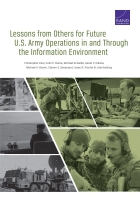by Christopher Paul
Research Questions
 What information-related practices or capabilities have U.S. allies employed effectively, and which could the U.S. Army adopt?
What information-related practices or capabilities have U.S. allies employed effectively, and which could the U.S. Army adopt?
What information-related practices or capabilities have adversaries or potential adversaries used effectively, and which of these could the Army adopt?
What are adversaries or potential adversaries doing in the information environment that the Army cannot consider doing because of ethical or legal constraints, and which of these should it be most prepared to counter?
Harnessing the power of old and new technology, it is easier than ever for U.S. allies and adversaries to reach — and influence — vast and varied audiences to achieve their strategic goals. Modern conflicts are fought as much in the information environment as on the physical battlefield, and the line between these domains is dissolving. Less sophisticated state actors and even nonstate actors have acquired capabilities previously available only to the most advanced nations to use information power in support of their objectives. Adversaries of the United States and its allies do not operate under the same legal and ethical constraints and are free to engage in offensive cyberwarfare, disseminate propaganda, censor traditional and online media, and threaten their detractors. As it prioritizes investments in future capabilities, the U.S. Army stands to benefit from an examination of the evolution of allied and adversary information campaigns, as well as their successes, failures, and potential future directions. This comparative analysis of 12 case studies highlights the capability areas in which others excel to guide the Army in either adopting or countering these principles and practices. A companion volume, Lessons from Others for Future U.S. Army Operations in and Through the Information Environment: Case Studies, supports this comparative analysis with detailed assessments of the information-related activities and strategic goals of a range of allies, adversaries, and potential adversaries.
Key Findings
Both State and Nonstate Actors Excelled in Multiple Capability Areas
Adversaries and potential adversaries excelled in the most capability areas, with China and Russia showing the largest number of strengths.
China, North Korea, Iran, and Russia all excelled in cyber operations and censorship and information control; these efforts were critical to disseminating messages and undermining conflicting information.
Nonstate actors were proficient in using physical effects, such as terrorist attacks, as part of their messaging, as well as promoting their messages on social media, influencing audiences, and using narrative to strengthen their messages.
Allies and Adversaries Are Guided by Several Common Concepts and Principles in the Information Environment
Effective allies, adversaries, and potential adversaries devoted a significant amount of attention to maintaining the support of their own populations and recognized the importance of high production values for messaging campaigns.
Effective adversaries and potential adversaries generously resourced their information-related capabilities relative to other efforts and gave information effects priority or prominence in their operations.
Across all cases, it was rare for information activities to be centralized or housed in a single organization, and few actors made an effort to carefully document their own operations. However, when these principles were followed, they proved effective.
Adversaries and Potential Adversaries Have Advantages in the Information Environment
Unconstrained by ethics, law, or policy, these actors can engage in practices that are effective but unacceptable under U.S. laws and values, including cyber aggression outside of declared hostilities, targeting domestic audiences, disseminating falsehoods or manipulating information, and censoring messages that undermine their objectives.
Recommendations
To generate support for its strategic goals and effectively counter the efforts of adversaries and potential adversaries, the Army should prioritize and sufficiently resource information-related activities.
To improve readiness and better integrate its capabilities, operations, and objectives, the Army should routinize and standardize its processes, promote a view of information power as part of combined arms, and bring the necessary capabilities out of the reserves. It should also clearly articulate its political, physical, and influence objectives in plans and communicate them to maneuver forces.
To improve its organization for operations in and through the information environment, the Army should tear down firewalls between public affairs and other information-related capabilities and seek expanded authorities to operate in situations short of declared hostilities.
To improve its ability to execute operations successfully in and through the information environment, the Army should close capacity gaps in key areas by increasing the size, attractiveness, and prestige of these career fields and specialties.
No comments:
Post a Comment